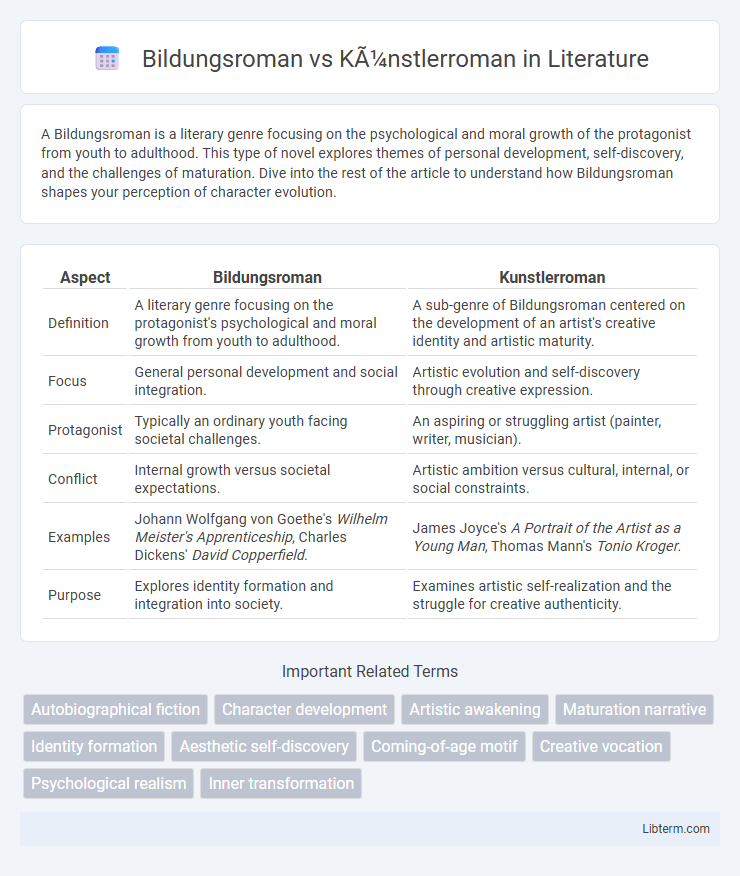A Bildungsroman is a literary genre focusing on the psychological and moral growth of the protagonist from youth to adulthood. This type of novel explores themes of personal development, self-discovery, and the challenges of maturation. Dive into the rest of the article to understand how Bildungsroman shapes your perception of character evolution.
Table of Comparison
| Aspect | Bildungsroman | Kunstlerroman |
|---|---|---|
| Definition | A literary genre focusing on the protagonist's psychological and moral growth from youth to adulthood. | A sub-genre of Bildungsroman centered on the development of an artist's creative identity and artistic maturity. |
| Focus | General personal development and social integration. | Artistic evolution and self-discovery through creative expression. |
| Protagonist | Typically an ordinary youth facing societal challenges. | An aspiring or struggling artist (painter, writer, musician). |
| Conflict | Internal growth versus societal expectations. | Artistic ambition versus cultural, internal, or social constraints. |
| Examples | Johann Wolfgang von Goethe's Wilhelm Meister's Apprenticeship, Charles Dickens' David Copperfield. | James Joyce's A Portrait of the Artist as a Young Man, Thomas Mann's Tonio Kroger. |
| Purpose | Explores identity formation and integration into society. | Examines artistic self-realization and the struggle for creative authenticity. |
Introduction to Bildungsroman and Künstlerroman
Bildungsroman, a genre stemming from German literature, centers on the protagonist's psychological and moral growth from youth to adulthood, illustrating their journey toward self-discovery and social integration. Kunstlerroman, a subgenre of Bildungsroman, specifically follows the development of an artist, emphasizing the creation of artistic identity alongside personal maturation. Both genres delve into themes of education, self-reflection, and societal roles, but Kunstlerroman uniquely explores the challenges and evolution tied to artistic creativity.
Defining Bildungsroman: Meaning and Origins
The Bildungsroman is a literary genre that explores the protagonist's psychological and moral growth from youth to adulthood, emphasizing personal development and self-discovery. Originating in early 19th-century Germany, its name derives from the German words "bildung" (education) and "roman" (novel), reflecting a narrative centered on education and formation. This genre often portrays a journey toward social integration, contrasting with the Kunstlerroman, which specifically focuses on the development of an artist's creative identity.
Defining Künstlerroman: Distinctive Features
Kunstlerroman is a literary genre focusing on the development of an artist's character, distinct from Bildungsroman by emphasizing artistic growth and creative struggles. It explores the protagonist's journey toward self-realization through art, highlighting internal conflicts, aesthetic philosophy, and the impact of societal pressures on artistic expression. Key features include the exploration of identity formation in relation to art, the tension between personal vision and external expectations, and the portrayal of the artist's evolving relationship with creativity.
Historical Development of Both Genres
The Bildungsroman originated in Germany in the late 18th century, emphasizing the protagonist's psychological and moral growth from youth to adulthood, reflecting Enlightenment ideals and societal shifts during the Industrial Revolution. The Kunstlerroman, a subgenre of the Bildungsroman, emerged in the 19th century, focusing specifically on the development of an artist's consciousness and creative identity within a restrictive society, highlighting Romantic ideals of individualism and self-expression. Both genres evolved through the works of authors like Goethe and Thomas Mann, influencing modern narratives on personal and artistic maturation.
Key Themes in Bildungsroman Narratives
Bildungsroman narratives center on the protagonist's psychological and moral growth from youth to adulthood, emphasizing themes of identity formation, social integration, and self-discovery. These stories often explore the conflict between individual desires and societal expectations, highlighting personal development through experience and education. The genre underscores the journey toward maturity, focusing on the protagonist's evolving worldview and internal struggles.
Artistic Focus in Künstlerroman Stories
Kunstlerroman centers on the development of an artist, emphasizing the protagonist's creative growth and struggles within their artistic field, distinguishing it from Bildungsroman's broader coming-of-age narrative. These stories explore the internal conflicts, social challenges, and self-realization involved in the pursuit of artistic expression and mastery. Notable examples include James Joyce's "A Portrait of the Artist as a Young Man" and Thomas Mann's "Tonio Kroger," which highlight the tension between personal creativity and societal expectations.
Major Works: Bildungsroman Exemplars
Major Bildungsroman exemplars include Johann Wolfgang von Goethe's "Wilhelm Meister's Apprenticeship," Charles Dickens' "David Copperfield," and James Joyce's "A Portrait of the Artist as a Young Man." These works emphasize the protagonist's psychological and moral growth within a social context. The Bildungsroman contrasts with the Kunstlerroman, which centers specifically on the development of an artist's creative identity.
Seminal Künstlerroman Novels
Seminal Kunstlerroman novels such as Goethe's "Wilhelm Meister's Apprenticeship" and Thomas Mann's "Tonio Kroger" explore the psychological and artistic development of protagonists striving for creative identity, differentiating themselves from Bildungsroman by emphasizing the struggles of the artist rather than general maturation. These works delve deeply into themes of aesthetic growth, societal alienation, and internal conflict, portraying the complexity of the artistic vocation within literary tradition. The Kunstlerroman genre significantly influences modern narratives about the artist's journey, highlighting the intersection of personal growth and artistic expression.
Comparative Analysis: Similarities and Differences
Bildungsroman and Kunstlerroman are literary genres centered on personal development, with Bildungsroman focusing on overall psychological and moral growth, while Kunstlerroman emphasizes the maturation of an artist and their creative identity. Both genres share themes of self-discovery, inner conflict, and societal challenges, yet Kunstlerroman often explores the struggles between artistic ambition and external expectations in greater depth. The distinction lies in Bildungsroman's broader scope of character development compared to Kunstlerroman's specific portrayal of artistic vocation and creative struggles.
Lasting Influence on Modern Literature
The Bildungsroman and Kunstlerroman genres have profoundly shaped modern literature by exploring personal growth and artistic development, respectively. Bildungsromans like "Jane Eyre" emphasize character maturation through experience, influencing contemporary narratives about identity and societal roles. Kunstlerromans such as James Joyce's "A Portrait of the Artist as a Young Man" examine the creative journey, inspiring modern stories centered on the complexities of artistic self-expression.
Bildungsroman Infographic

 libterm.com
libterm.com